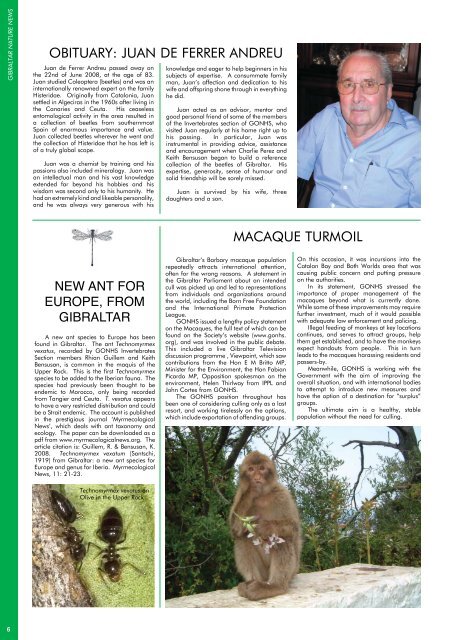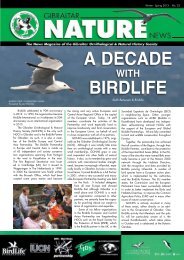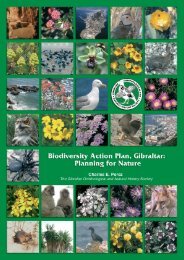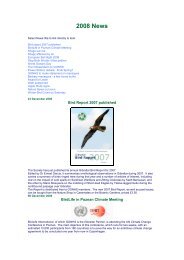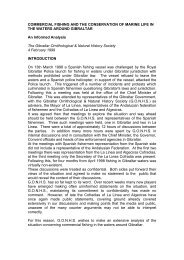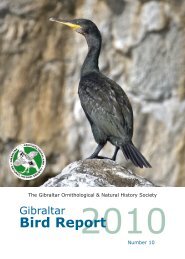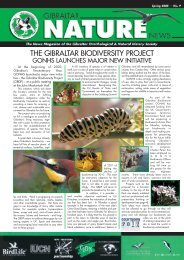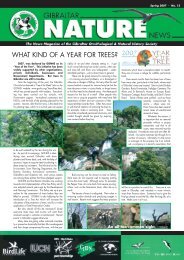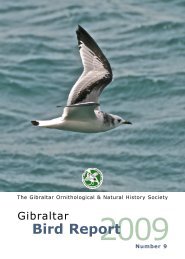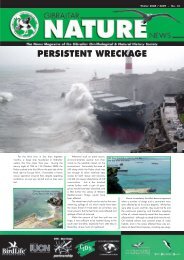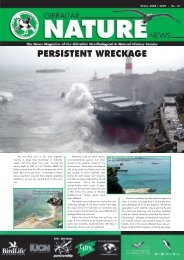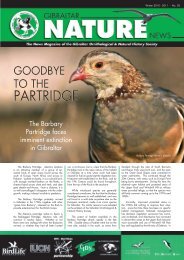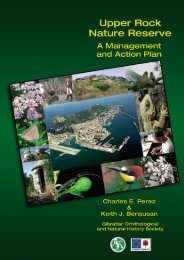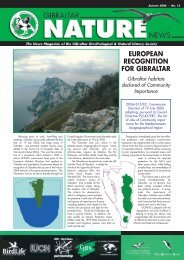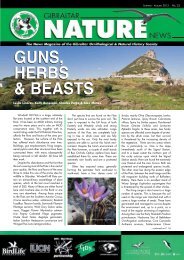No.15 - Gibraltar Ornithological & Natural History Society
No.15 - Gibraltar Ornithological & Natural History Society
No.15 - Gibraltar Ornithological & Natural History Society
You also want an ePaper? Increase the reach of your titles
YUMPU automatically turns print PDFs into web optimized ePapers that Google loves.
GIBRALTAR NATURE NEWS<br />
6<br />
OBITUARY: JUAN DE FERRER ANDREU<br />
Juan de Ferrer Andreu passed away on<br />
the 22nd of June 2008, at the age of 83.<br />
Juan studied Coleoptera (beetles) and was an<br />
internationally renowned expert on the family<br />
Histeridae. Originally from Catalonia, Juan<br />
settled in Algeciras in the 1960s after living in<br />
the Canaries and Ceuta. His ceaseless<br />
entomological activity in the area resulted in<br />
a collection of beetles from southernmost<br />
Spain of enormous importance and value.<br />
Juan collected beetles wherever he went and<br />
the collection of Histeridae that he has left is<br />
of a truly global scope.<br />
Juan was a chemist by training and his<br />
passions also included mineralogy. Juan was<br />
an intellectual man and his vast knowledge<br />
extended far beyond his hobbies and his<br />
wisdom was second only to his humanity. He<br />
had an extremely kind and likeable personality,<br />
and he was always very generous with his<br />
NEW ANT FOR<br />
EUROPE, FROM<br />
GIBRALTAR<br />
A new ant species to Europe has been<br />
found in <strong>Gibraltar</strong>. The ant Technomyrmex<br />
vexatus, recorded by GONHS Invertebrates<br />
Section members Rhian Guillem and Keith<br />
Bensusan, is common in the maquis of the<br />
Upper Rock. This is the first Technomyrmex<br />
species to be added to the Iberian fauna. The<br />
species had previously been thought to be<br />
endemic to Morocco, only being recorded<br />
from Tangier and Ceuta. T. vexatus appears<br />
to have a very restricted distribution and could<br />
be a Strait endemic. The account is published<br />
in the prestigious journal ‘Myrmecological<br />
News’, which deals with ant taxonomy and<br />
ecology. The paper can be downloaded as a<br />
pdf from www.myrmecologicalnews.org. The<br />
article citation is: Guillem, R. & Bensusan, K.<br />
2008. Technomyrmex vexatum (Santschi,<br />
1919) from <strong>Gibraltar</strong>: a new ant species for<br />
Europe and genus for Iberia. Myrmecological<br />
News, 11: 21-23.<br />
Technomyrmex vexatus on<br />
Olive in the Upper Rock<br />
knowledge and eager to help beginners in his<br />
subjects of expertise. A consummate family<br />
man, Juan’s affection and dedication to his<br />
wife and offspring shone through in everything<br />
he did.<br />
Juan acted as an advisor, mentor and<br />
good personal friend of some of the members<br />
of the Invertebrates section of GONHS, who<br />
visited Juan regularly at his home right up to<br />
his passing. In particular, Juan was<br />
instrumental in providing advice, assistance<br />
and encouragement when Charlie Perez and<br />
Keith Bensusan began to build a reference<br />
collection of the beetles of <strong>Gibraltar</strong>. His<br />
expertise, generosity, sense of humour and<br />
solid friendship will be sorely missed.<br />
Juan is survived by his wife, three<br />
daughters and a son.<br />
<strong>Gibraltar</strong>’s Barbary macaque population<br />
repeatedly attracts international attention,<br />
often for the wrong reasons. A statement in<br />
the <strong>Gibraltar</strong> Parliament about an intended<br />
cull was picked up and led to representations<br />
from individuals and organizations around<br />
the world, including the Born Free Foundation<br />
and the International Primate Protection<br />
League.<br />
GONHS issued a lengthy policy statement<br />
on the Macaques, the full text of which can be<br />
found on the <strong>Society</strong>’s website (www.gonhs.<br />
org), and was involved in the public debate.<br />
This included a live <strong>Gibraltar</strong> Television<br />
discussion programme , Viewpoint, which saw<br />
contributions from the Hon E M Britto MP,<br />
Minister for the Environment, the Hon Fabian<br />
Picardo MP, Opposition spokesman on the<br />
environment, Helen Thirlway from IPPL and<br />
John Cortes from GONHS.<br />
The GONHS position throughout has<br />
been one of considering culling only as a last<br />
resort, and working tirelessly on the options,<br />
which include exportation of offending groups.<br />
MACAQUE TURMOIL<br />
On this occasion, it was incursions into the<br />
Catalan Bay and Both Worlds area that was<br />
causing public concern and putting pressure<br />
on the authorities.<br />
In its statement, GONHS stressed the<br />
importance of proper management of the<br />
macaques beyond what is currently done.<br />
While some of these improvements may require<br />
further investment, much of it would possible<br />
with adequate law enforcement and policing.<br />
Illegal feeding of monkeys at key locations<br />
continues, and serves to attract groups, help<br />
them get established, and to have the monkeys<br />
expect handouts from people. This in turn<br />
leads to the macaques harassing residents and<br />
passers-by.<br />
Meanwhile, GONHS is working with the<br />
Government with the aim of improving the<br />
overall situation, and with international bodies<br />
to attempt to introduce new measures and<br />
have the option of a destination for “surplus”<br />
groups.<br />
The ultimate aim is a healthy, stable<br />
population without the need for culling.


